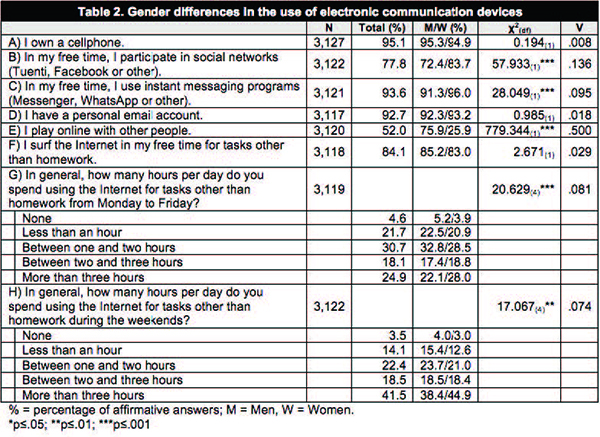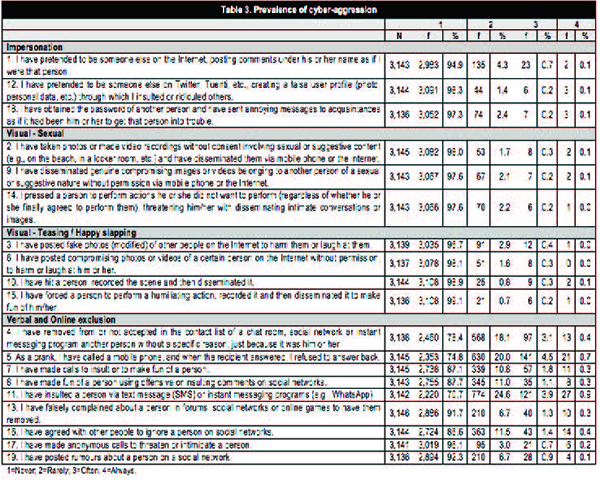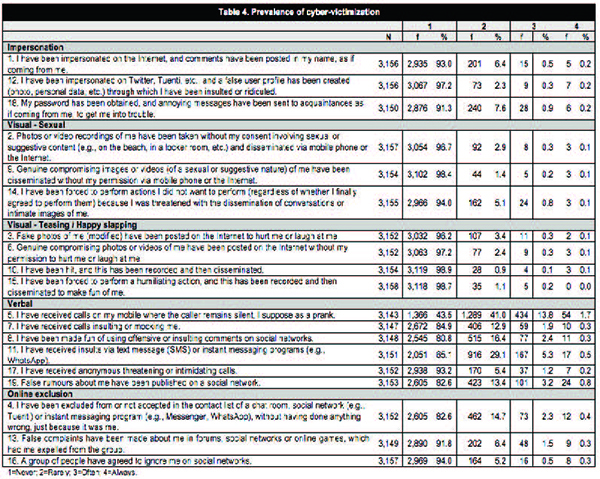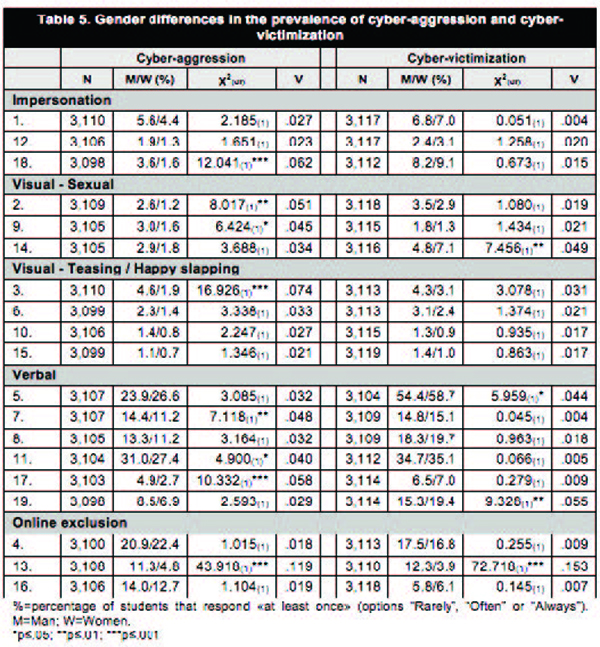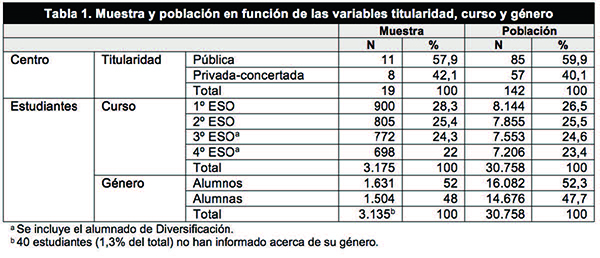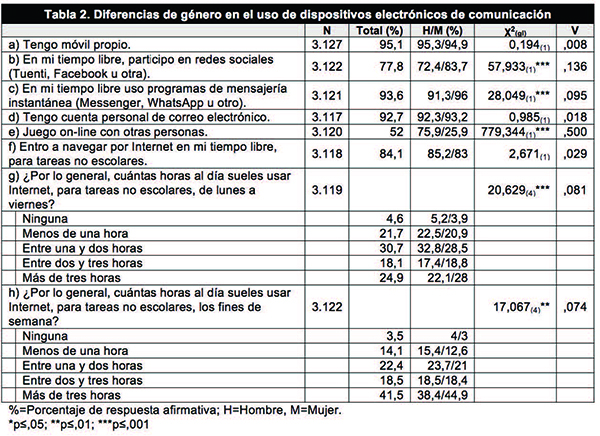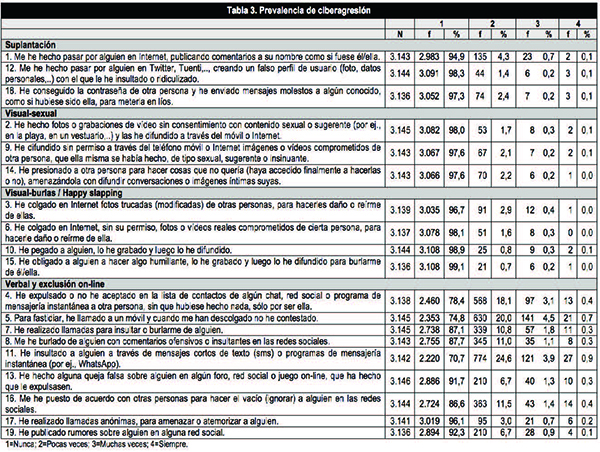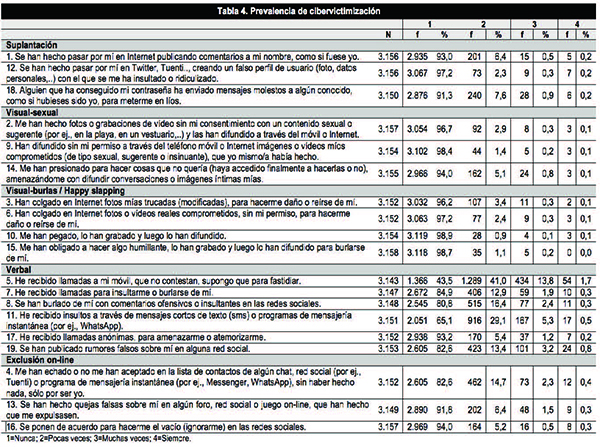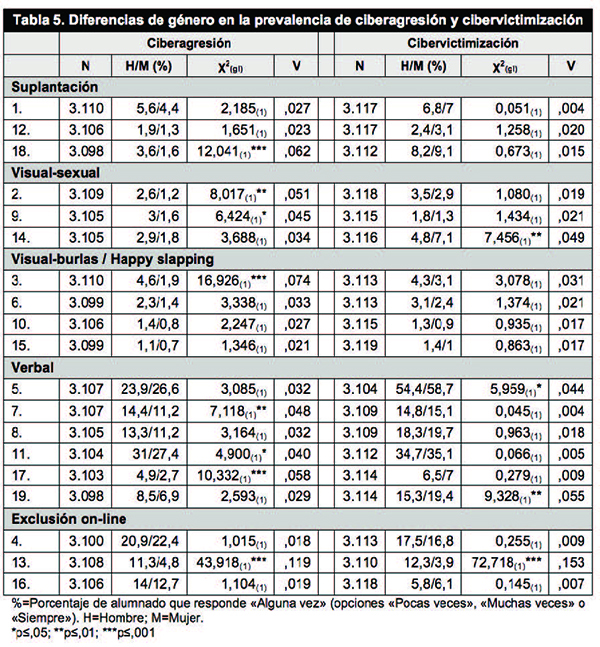Pulsa aquí para ver la versión en Español (ES)
Abstract
The objective of the present work is to analyse the prevalence of cyber-aggression and cyber-victimization among adolescents in Asturias (Spain) and to identify possible gender differences. To this end, 3,175 adolescents aged 12 to 18 years were randomly selected from the student population attending compulsory secondary education in Asturias and assessed. They completed three self-reported tests: an ad hoc questionnaire on sociodemographic data and communication technologies management; the “Cyber-aggression Questionnaire for Adolescents” (CYBA), to assess how frequently adolescents acknowledge having exercised various cyber-aggressive behaviours in the previous three months; and the “Cyber-victimization Questionnaire for Adolescents” (CYVIC), to assess how frequently adolescents acknowledge having been a victim of various types of cyber-aggression in the previous three months. The results obtained show a high variation in prevalence based on the type of cyber-aggression or cyber-victimization analysed. Verbal cyber-aggression and online exclusion are more common than impersonation and visual cyber-aggression. There are generally no statistically significant differences between boys and girls. When differences do appear, boys generally tend to be more aggressive than girls, while girls are more likely to be victims. However, these differences are either small or very small. The implications of these results for future research and educational treatment of the problem are discussed.
1. Introduction
Electronic communication devices have become an essential means of adolescent socialization, and appropriate use of these devices is thus a necessary educational goal. These devices offer great advantages in terms of establishing new friendships and keeping in contact with family and friends. However, improper use may involve risks. Electronic communication devices can be used to intentionally damage, disturb or harm (i.e., attack) individuals or groups. Generally, the terms “cyber-aggression” and “cyber-victimization” are used to refer to situations in which a person attacks or is attacked via electronic communication devices (Corcoran, McGuckin, & Prentice, 2015).
Cyber-aggression possesses characteristics and effects that make it particularly problematic and worthy of attention. Compared with traditional forms of violence, aggression via electronic device helps to protect aggressors’ anonymity and thus abets disinhibition of conduct. In many cases, the aggressor does not witness the consequences of his or her actions on the victim, which hinders empathizing with him or her. Aggression may occur at any time or place, which complicates monitoring and control on the part of adults. In addition, harmful content can be sent to many people in a very short time, which amplifies harm to victims (Hinduja & Patchin, 2015). Cyber-aggression can have significant negative effects, not only on the victim but also on the aggressor. Cyber-victimization has been associated with an increase in internalised problems, mainly related with depressive symptomatology. In adolescents, such symptoms may adversely affect concentration and academic performance (Kowalski, Giumetti, Schroeder, & Lattanner, 2014). Cyber-aggressors may perceive that their inappropriate behaviour is encouraged, which can favour its generalization to other areas and situations (Yahner, Dank, Zweig, & Lachman, 2015). Detecting cyber-aggression may lead to significant legal consequences for those who exercise or enable it (Paul, Smith, & Blumberg, 2012).
Determining the prevalence of cyber-aggression among adolescents is difficult. The few published studies with Spanish samples differ regarding the indicators that define the construct and the methodology used (mainly, sample characteristics, time period of inquiry, scale values used and result format in means or percentages). However, the results do reveal a trend. The most common types of cyber-aggression and cyber-victimization are “verbal cyber-aggression” (harmful comments online; threatening or insulting text messages; frightening anonymous calls) and “exclusion” (deliberately excluding a person from an online group). Conversely, the least common type is “visual cyber-aggression”, including both “sexual cyber-aggression” (recording or photographing and disseminating compromising private images) and “happy slapping” (physically assaulting or forcing a person to perform a humiliating action, recording it and disseminating it). When “impersonation” is included in the analysis, its prevalence levels are higher than for visual aggression and closer to those for verbal aggression and exclusion (Buelga, Cava, Musitu, & Torralba, 2015; Calvete, Orue, Estévez, Villardón, & Padilla, 2010; Díaz-Aguado, Martínez, & Martín, 2013; Garaigordobil, 2015). To the best of our knowledge, no study on cyber-aggression prevalence in Asturias (Spain), in which adolescents report as victims or aggressors and which uses a specific sample that is broad and representative of the region, has yet been published.
A key aspect to understanding the problem, which has educational implications, is to observe whether there are significant differences between boys and girls in the frequency and manner with which they exercise or experience cyber-aggression. Given that boys and girls make differential use of mobile phones and the Internet (Fernández, Peñalva, & Irazabal, 2015) and that there are gender differences in on-site aggression (Card, Stucky, Sawalani, & Little, 2008), it is plausible that there are also differences in cyber-aggression. However, studies on the subject yield inconsistent results. A recent systematic review (Navarro, 2016) displays six patterns of results, which are, in order of frequency: no differences in cyber-aggression or in cyber-victimization based on gender; boys more frequently act as aggressors and girls as victims; boys become aggressors and victims more frequently than girls; boys act as aggressors more frequently than girls, but there are no differences in victimization; there are no differences in aggression, but girls are victims more frequently than boys; and finally, girls act as aggressors and victims more frequently than boys. One possible way to clarify the relationship between gender and cyber-aggression is to precisely delineate the situations that are considered cyber-victimization and cyber-aggression and to analyse possible specific differences in the different types of circumstances that define the construct.
For this reason, the present study has two objectives. First, the study aims to analyse the prevalence of cyber-aggression and cyber-victimization among adolescents in Asturias. A pattern consistent with that reported in the few studies on the topic previously published in Spain is expected to be found. Second, the study intends to identify possible gender differences in the prevalence of cyber-aggression and cyber-victimization. No large differences are anticipated, or if found, boys are expected to become aggressors more commonly than girls and girls to become victims more frequently than boys.
2. Material and methods
2.1. Participants
The sample universe comprises the total number of adolescents in Asturias in compulsory secondary education (CSE) and studying in educational centres supported by public funds (public and state-subsidised) in the region. According to data provided by the statistics service of the Regional Ministry of Education and Culture, during the 2014/15 academic year, 30,758 students (97.6% of the total number of students in CSE in Asturias) were enrolled in these schools.
The sample analysed in this study was selected through random stratified and cluster sampling. To this end, the population of the CSE centres supported by public funds in Asturias was divided into seven geographical areas. In each one of these, a number of centres proportional to the total number of centres in that population area was randomly selected. As a result, 19 centres were ultimately selected. In each selected centre, all CSE students were assessed, yielding a total of 3,175 students aged between 12 and 18 years (M=14.01, DT=1.39) actually assessed.
The proportional allocation of centres to each geographical area ensured sample representativeness in terms of geographic location. The centres are located in both urban and rural environments and receive students from heterogeneous socio-economic levels. The aim of the random selection of centres within each geographical area was to provide a sample that was also representative of the population in terms of other relevant variables such as gender, grade year or centre ownership. As shown in table 1, the sample presents a percentage similar to that of the population in terms of ownership, grade year and gender.
2.2. Assessment tools
“Ad hoc questionnaire on sociodemographic data and management of communication technologies”. Composed of 11 items, it gathers information on students’ age, gender and grade year as well as the incidence and frequency of use of electronic communication devices. The age and grade year were evaluated via two open questions. The other variables were evaluated using dichotomous or multiple-choice items.
“Cyber-aggression Questionnaire for Adolescents” (CYBA) (Álvarez-García, Barreiro-Collazo, Núñez, & Dobarro, 2016). The CYBA is a self-reported questionnaire that is composed of 19 items with a Likert-type response format in which the adolescent must indicate how frequently he or she has exercised the aggression described in each statement via mobile phone or the Internet in the previous three months (from 1=Never to 4=Always). After exploratory and confirmatory factorial analysis, the test provides a structure composed of three factors (“impersonation”, a=.87; “visual-sexual cyber-aggression”, a=.79; and “verbal cyber-aggression and exclusion”, a=.91) and four additional indicators of “visual cyber-aggression-teasing/happy slapping”.
“Cyber-victimization questionnaire for adolescents” (CYVIC). Self-reported, it assesses how frequently the informant has been the victim of attacks via mobile phone or the Internet during the previous three months. It consists of 19 statements, with the same indicators and response format (from 1=Never to 4=Always) as the CYBA. After exploratory and confirmatory factorial analysis, the test provides a structure composed of four factors (“impersonation”, a=.81; “visual-sexual cyber-victimization”, a=.77; “verbal cyber-victimization”, a=.87; and “online exclusion”, a=.73) and four additional indicators of “visual cyber-victimization-teasing/happy slapping”. The factorial structure of CYVIC is the same as that of the CYBA, except that the items in the “verbal cyber-aggression and exclusion” factor are split into two factors: “verbal cyber-victimization” and “online exclusion”.
2.3. Procedure
After selecting the educational centres, authorization to administer the questionnaires was requested from the centres’ respective management teams. The latter were informed of the study’s objectives and procedures, the anonymous and voluntary participation of students, and the confidential treatment of the results. As participants were underage, permission was requested from their families through passive consent. The teenagers were evaluated during the second or third trimester of the 2014/15 academic year, depending on the availability of each centre. Before answering the questionnaire, teenagers were also informed of the study’s objectives and of its anonymous, confidential and voluntary nature. In general, students had 20 minutes to answer, although this period was flexible depending on the age and characteristics of the respondents. The test was administered to all CSE groups in each centre during school hours.
2.4. Data analysis
After the data were obtained, the information was analysed with the statistical package SPSS 21.0 (IBM Corp., 2012). First, the percentage of participants using different electronic communication devices and applications was analysed, as well as the association between use and gender. Then, the prevalence of cyber-aggression and cyber-victimization among the adolescents was analysed in terms of frequency and percentages. Finally, the possible association between prevalence and gender was examined. Due to the low reported frequency of cyber-aggression and cyber-victimization, the responses to the CYBA and CIVIC questionnaires were reclassified into two response options: “Never” and “At least once”. The option “At least once” resulted from grouping the original options “Rarely”, “Often” and “Always”. The existence of a statistically significant association between the variables studied and gender was analysed using Pearson's chi-squared test. The magnitude of the association was analysed using Cramer's V.
3. Results
3.1. Use of mobile phones and the Internet
The use of mobile phones, instant messaging and email is almost universal among the adolescents assessed. Over 90% of them reported having access to these resources (table 2). Browsing the Internet to complete non-school related tasks is also very common, as is using social networks (although the minimum legal age in Spain for its use is 14). Playing online games with others is less common, particularly among girls.
Within its high percentage of general use, the use of social networks (p<.001) and of instant messaging programs (p<.001) is more common among girls than boys (table 2). Girls also use the Internet to perform non-school related tasks for more hours than boys, both from Monday to Friday (p<.001) and during the weekends (p=.002). In contrast, boys play online with other people significantly more frequently than girls (p<.001). There are no statistically significant differences in the percentage of boys and girls who have a mobile phone or personal email account or who browse the Internet in their free time for non-school related tasks.
3.2. Prevalence of cyber-aggression and cyber-victimization
The percentage of adolescents who reported having exercised or experienced aggression via mobile phone or the Internet during the previous three months is very variable, depending on the kind of aggression analysed (tables 3 and 4). However, for most indicators, the percentage of participants involved is low or very low. Both in the case of cyber-aggression and cyber-victimization, verbal abuse and online exclusion are more common than visual aggression and impersonation. More specifically, the most common types of cyber-aggression and cyber-victimization are phone pranks in which, when the receiver picks up, the caller does not answer (item 5) and insults via text message or instant messaging programs (item 11). The least common are the recording and dissemination of physical aggression (item 10) or humiliating acts performed under threat (item 15).
3.3. Gender differences in the prevalence of cyber-aggression and cyber-victimization
As shown in table 5, there are no statistically significant differences in gender for most indicators, and when such differences appear, their magnitude is small or very small.
Regarding cyber-aggression, there are statistically significant differences between boys and girls for 8 of the 19 indicators analysed. In these eight cases, cyber-aggression is more prevalent in boys than in girls. To a greater extent than girls, boys report having obtained a person’s password and sent messages to an acquaintance as if they were that person to get him/her into trouble (item 18; p=.001); having taken photos or made video recordings without consent involving sexual or suggestive content and disseminated them via mobile phone or the Internet (item 2; p=.005); having disseminated genuine compromising images or videos of a sexual or suggestive nature belonging to another person without permission via mobile phone or the Internet (item 9; p=.011); having posted fake photos belonging to another person on the Internet to harm or make fun of them (item 3; p<.001); having made calls insulting or mocking another person (item 7; p=.008); having insulted a person via text message or instant messaging programs (item 11; p=.027); having made anonymous calls to threaten or intimidate a person (item 17; p=.001); and having made false complaints about a person in a forum, social network or online game to have that person removed from the site (item 13; p<.001) during the previous three months.
With regard to cyber-victimization, there are statistically significant differences between boys and girls for 4 of the 19 indicators analysed. In three cases, cyber-victimization is more prevalent in girls, and in one case, in boys. A higher percentage of girls compared with boys report having been victims of false rumours on a social network (item 19; p=.002); having received calls to their mobile phones with no response as a prank (item 5; p=.015); or having been pressured into performing actions they did not want to perform because they were threatened with the dissemination of conversations or intimate images (item 14; p=.006) during the previous three months. In contrast, a higher percentage of boys reported having been victims during the previous three months of false complaints in forums, social networks or online games resulting in their removal from the site (item 13; p<.001).
4. Discussion and conclusions
The present work started with two objectives: to analyse the prevalence of cyber-aggression and cyber-victimization among adolescents in Asturias and to identify possible gender differences. With regard to the first objective, the trend in results obtained is, as expected, to a large extent consistent with the findings of previous studies in Spain (Buelga & al., 2015; Calvete & al., 2010; Díaz-Aguado & al., 2013; Garaigordobil, 2015). Verbal aggression and online exclusion are more common than visual aggression. However, unlike previous studies, in the present work the prevalence of impersonation is closer to that of visual aggression than that of verbal aggression and exclusion. This may be due to the different indicators used.
The percentage of adolescents who report having exhibited cyber-aggressive behaviours varies from 0.9% who claim at least once to have forced a person to perform a humiliating action, recorded it and then disseminated it to make fun of that person to 29.3% who claim to have insulted a person using text message or instant messaging programs. The percentage of adolescents who report having experienced cyber-victimization varies from 1.1% who claim to have been hit or forced to perform a humiliating action, been recorded and then had the video or picture disseminated to 56.5% who claim to have received prank calls on their mobile phone with no response.
Regarding educational practice, these results show that although the prevalence of most of these behaviours is low, all types of cyber-aggression and cyber-victimization assessed appear to some extent in the analysed sample. It is therefore necessary to devise measures for prevention and treatment, in particular considering that the effects of these behaviours can be very negative (Kowalski & al., 2014). It is important to address and prevent not only the most serious but also those apparently milder instances (verbal cyber-aggression and online exclusion) that are nonetheless the most frequent and may become part of a continued rejection or harassment pattern. Therefore, educating adolescents regarding the ethical and prudent use of communication technologies is essential (Cerezo & al., 2016; Del Rey, Casas, & Ortega, 2012).
With regard to the second objective, the results obtained are in line with expectations and consistent with the most recently published studies (Navarro, 2016). In the present study, there are generally no statistically significant differences between boys and girls. In the few cases in which differences appear, boys are aggressors more frequently than girls, while girls are victims more frequently than boys (these differences are, however, small or very small). The only exception to this trend is that boys report having been victims of false complaints in forums, social networks or online games resulting in their removal from those sites more frequently than girls. A possible explanation for this exception is the significantly greater use that boys make of multiplayer online games compared with girls.
The results obtained lead to several conclusions regarding the interplay between gender and the frequency of use of mobile phones and the Internet as risk factors for cyber-aggression and cyber-victimization in adolescence. Previous studies conclude, as it would be expected intuitively, that the mere use of electronic communication devices constitutes a risk factor (Kowalski & al., 2014). While this is true in general terms, it is notable that in the present study, while girls make greater use of social networking and instant messaging programs than boys and use the Internet for non-school related tasks for longer periods of time, they do not attack others more frequently than boys via these means. It is also notable that higher usage does not translate into higher probabilities of generalized cyber-victimization via such means. In fact, for two of the three indicators in which girls are more likely to be victims than boys (having received prank calls to their phones without response and having been a victim of false rumours on a social network), the use of these resources in particular did not seem a priori a relevant variable. There are other more powerful risk factors (Álvarez-García, García, & Núñez, 2015; Álvarez-García, Núñez, Dobarro, & Rodríguez, 2015).
Regarding educational practice, the results obtained suggest the importance of taking into account the gender perspective in the prevention of the issue. On the one hand, reproducing the traditional model of masculinity associated with rudeness, insensitivity and aggression should be avoided (Gini & Pozzoli, 2006). In the present study, although differences in prevalence are neither numerous nor large, boys tend to be more aggressive, and girls, victims. Boys also engage in more direct violence (insults, threats), and girls experience indirect violence more frequently (rumours). On the other hand, preventing gender cyber-violence is of paramount importance. In the present study, a greater percentage of boys, compared with girls, acknowledge having disseminated compromising images, involving sexual or suggestive content, without the consent of the victim, and a higher percentage of girls, compared with boys, claim to have been pressured into performing unwanted actions under the threat of having their conversations or intimate images disseminated. In this regard, educating students regarding values, attitudes and skills (respecting the privacy of individuals, being empathetic, etc.) that reduce the possibility of becoming aggressors is important. Teaching basic aspects of cyber-security and avoidance of risky behaviours to students is also essential to reduce the possibility of their becoming victims (Flores, 2014). In recent years, legislative changes have occurred, and various proposals to promote coeducation and to prevent gender-based violence have been published (Edwards & Hinsz, 2014). The present work advocates including the relationship with electronic devices in this training.
For all these reasons, this study constitutes a contribution to the understanding of cyber-aggression and cyber-victimization among adolescents. It adds to the limited number of studies on Spanish samples previously published on prevalence and gender differences, providing updated data and contributing to clarifying certain aspects of the inconsistent evidence available previously. Nevertheless, it has several limitations. First, the data are self-reported, which can generate biased responses due to distortion or social desirability, although minimizing them is attempted by ensuring anonymity and result confidentiality. Second, a large and representative population sample is used, but it is limited to a particular geographical area and specific ages. Any generalization of these results to other populations must be exercised with caution. It would be advisable to replicate this study with other samples in order to analyse the results’ external validity.
Acknowledgements
This work has been funded by the Regional Ministry of Economy and Employment of the Principality of Asturias (Spain) (Ref. FC-15-GRUPIN14-053).
References
Álvarez-García, D., Barreiro-Collazo, A., Núñez, J.C., & Dobarro, A. (2016). Validity and Reliability of the Cyber-aggression Questionnaire for Adolescents (CYBA). The European Journal of Psychology Applied to Legal Context, 8, 69-77. https://doi.org/10.1016/j.ejpal.2016.02.003
Álvarez-García, D., García, T., & Núñez, J.C. (2015). Predictors of School Bullying Perpetration in Adolescence: A Systematic Review. Aggression and Violent Behavior, 23, 126-136. https://doi.org/10.1016/j.avb.2015.05.007
Álvarez-García, D., Núñez, J.C., Dobarro, A., & Rodríguez, C. (2015). Risk Factors Associated with Cybervictimization in Adolescence. International Journal of Clinical and Health Psychology, 15(3), 226-235. https://doi.org/10.1016/j.ijchp.2015.03.002
Buelga, S., Cava, M.J., Musitu, G., & Torralba, E. (2015). Cyberbullying Aggressors among Spanish Secondary Education Students: An Exploratory Study. Interactive Technology and Smart Education, 12(2), 100-115. https://doi.org/10.1108/ITSE-08-2014-0025
Calvete, E., Orue, I., Estévez, A., Villardón, L., & Padilla, P. (2010). Cyberbullying in Adolescents: Modalities and Aggressors’ Profile. Computers in Human Behavior, 26, 1128-1135. https://doi.org/10.1016/j.chb.2010.03.017
Card, N.A., Stucky, B.D., Sawalani, G.M., & Little, T.D. (2008). Direct and Indirect Aggression during Childhood and Adolescence: A Meta-Analytic Review of Gender Differences, Intercorrelations, and Relations to Maladjustment. Child Development, 79(5), 1185-1229. https://doi.org/10.1111/j.1467-8624.2008.01184.x
Cerezo, F., Arnaiz, P., Giménez, A.M., & Maquilón, J.J. (2016). Conductas de ciberadicción y experiencias de cyberbullying entre adolescentes. Anales de Psicología, 32(3), 761-769. https://doi.org/10.6018/analesps.32.3.217461
Corcoran, L., Mc Guckin, C., & Prentice, G. (2015). Cyberbullying or Cyber Aggression? A Review of Existing Definitions of Cyber-Based Peer-to-Peer Aggression. Societies, 5, 245-255. https://doi.org/10.3390/soc5020245
Del Rey, R., Casas, J.A., & Ortega, R. (2012). El programa ConRed, una práctica basada en la evidencia [The ConRed Program, an Evidence-based Practice]. Comunicar, 39, 129-138. https://doi.org/10.3916/C39-2012-03-03
Díaz-Aguado, M.J., Martínez, R., & Martín, J. (2013). El acoso entre adolescentes en España. Prevalencia, papeles adoptados por todo el grupo y características a las que atribuyen la victimización. Revista de Educación, 362, 348-379. https://doi.org/10.4438/1988-592X-RE-2011-362-164
Edwards, S.R., & Hinsz, V.B. (2014). A Meta-Analysis of Empirically Tested School-Based Dating Violence Prevention Programs. SAGE Open, 4, 1-8. https://doi.org/10.1177/2158244014535787
Fernández, J., Peñalva, M.A., & Irazabal, I. (2015). Hábitos de uso y conductas de riesgo en Internet en la preadolescencia [Internet Use Habits and Risk Behaviours in Preadolescence]. Comunicar, 44, 113-120. https://doi.org/10.3916/C44-2015-12
Flores, J. (2014). Ciberviolencia de género y sexual en la adolescencia. Guía de apoyo para profesionales. Bilbao: Pantallas Amigas.
Garaigordobil, M. (2015). Ciberbullying en adolescentes y jóvenes del País Vasco: Cambios con la edad. Anales de Psicología, 31(3), 1069-1076. https://doi.org/10.6018/analesps.31.3.179151
Gini, G., & Pozzoli, T. (2006). The Role of Masculinity in Children’s Bullying. Sex Roles, 54, 585-588. https://doi.org/10.1007/s11199-006-9015-1
Hinduja, S., & Patchin, J.W. (2015). Bullying Beyond the Schoolyard (2nd Ed.). Thousand Oaks, CA: Corwin.
IBM Corp. (2012). SPSS Statistics for Windows, Version 21.0. Armonk, NY: IBM Corp.
Kowalski, R.M., Giumetti, G.W., Schroeder, A.N., & Lattanner, M.R. (2014). Bullying in the Digital Age: A Critical Review and Meta-analysis of Cyberbullying Research among Youth. Psychological Bulletin, 140(4), 1073-1137. https://doi.org/10.1037/a0035618
Navarro, R. (2016). Gender Issues and Cyberbullying in Children and Adolescents: From Gender Differences to Gender Identity Measures. In R. Navarro, S. Yubero, & E. Larrañaga (Eds.). Cyberbullying across the Globe: Gender, Family, and Mental Health (pp. 35-61). Cham (ZG): Springer.
Paul, S., Smith, P.K., & Blumberg, H.H. (2012). Investigating Legal Aspects of Cyberbullying. Psicothema, 24(4), 640-645. (http://goo.gl/gMhzb5) (2016-08-10).
Yahner, J., Dank, M., Zweig, J.M., & Lachman, P. (2015). The Co-Occurrence of Physical and Cyber Dating Violence and Bullying Among Teens. Journal of Interpersonal Violence, 30(7), 1079-1089. https://doi.org/10.1177/0886260514540324
Click to see the English version (EN)
Resumen
El presente trabajo tiene como objetivos analizar la prevalencia de la ciberagresión y la cibervictimización entre adolescentes en Asturias (España) e identificar posibles diferencias de género. Para ello, fueron evaluados 3.175 adolescentes, de 12 a 18 años, seleccionados aleatoriamente de entre la población de estudiantes de Educación Secundaria Obligatoria de Asturias. Se aplicaron tres autoinformes: un cuestionario «ad hoc» sobre datos sociodemográficos y manejo de tecnologías de comunicación; el «Cuestionario de Ciberagresión para Adolescentes» (CYBA), para evaluar con qué frecuencia el adolescente evaluado reconoce haber ejercido diferentes conductas de ciberagresión durante los últimos tres meses; y el «Cuestionario de Cibervictimización para adolescentes» (CYVIC), para evaluar con qué frecuencia el adolescente reconoce haber sido víctima de diferentes tipos de ciberagresión en los últimos tres meses. Los resultados obtenidos muestran una prevalencia muy variable en función del tipo de ciberagresión o cibervictimización analizado. La ciberagresión verbal y la exclusión online son más habituales que la suplantación y la ciberagresión visual. Por lo general, no existen diferencias estadísticamente significativas entre chicos y chicas. En los casos en que existen, la tendencia general es que los chicos son más agresores que las chicas y las chicas más víctimas que los chicos, si bien las diferencias son pequeñas o muy pequeñas. Se discuten las implicaciones de estos resultados para la investigación futura y el tratamiento educativo del problema.
1. Introducción
Los dispositivos electrónicos de comunicación se han convertido en un medio fundamental para la socialización de los adolescentes; y su correcto uso, en un objetivo educativo necesario. Estos dispositivos ofrecen grandes ventajas para establecer nuevas amistades y para mantener el contacto con familiares y amigos. Sin embargo, su uso inapropiado puede dar lugar a algunos peligros. Entre ellos, estos medios pueden ser usados para dañar, molestar o perjudicar de forma intencionada (es decir, para agredir) a personas o colectivos. Habitualmente se utilizan los términos «ciberagresión» y «cibervictimización» para hacer referencia a situaciones en las que alguien ejerce o padece, respectivamente, agresiones a través de dispositivos electrónicos de comunicación (Corcoran, McGuckin, & Prentice, 2015).
Las ciberagresiones presentan algunas características y efectos que las hacen especialmente problemáticas y dignas de atención. En comparación con las agresiones en el contexto físico, las agresiones a través de dispositivos electrónicos favorecen el anonimato por parte del agresor y, con ello, la desinhibición de su conducta. En muchos casos, el agresor no presencia las consecuencias sobre la víctima, lo que dificulta que empatice con ella. Pueden ocurrir en cualquier momento y lugar, lo que complica la supervisión y control por parte de los adultos. Además, el contenido dañino puede ser enviado a mucha gente en muy poco tiempo, lo que multiplica el daño hacia la víctima (Hinduja & Patchin, 2015). Las ciberagresiones pueden generar importantes efectos negativos, no sólo sobre la víctima, sino también sobre el agresor. La cibervictimización se ha asociado a un aumento de problemas internalizados, principalmente relacionados con sintomatología depresiva, que en adolescentes puede afectar negativamente a la concentración y al rendimiento académico (Kowalski, Giumetti, Schroeder, & Lattanner, 2014). Los ciberagresores pueden ver incentivado su comportamiento inapropiado, lo que puede favorecer su generalización a otros ámbitos y situaciones (Yahner, Dank, Zweig, & Lachman, 2015). Si la ciberagresión es detectada, puede conllevar importantes consecuencias legales para quienes la ejercen o posibilitan (Paul, Smith, & Blumberg, 2012).
Resulta difícil precisar la prevalencia de la ciberagresión entre adolescentes. Los escasos estudios publicados con muestra española difieren en los indicadores que definen el constructo y en la metodología empleada (principalmente, las características de la muestra, el periodo de tiempo por el que se pregunta, los valores de la escala utilizada y el formato de los resultados -medias o porcentajes-). Sin embargo, se observa una tendencia de resultados. Los tipos de ciberagresión y cibervictimización más habituales son la «verbal» (comentarios dañinos a través de Internet; mensajes de texto amenazantes o insultantes; llamadas anónimas para atemorizar) y la «exclusión» (excluir deliberadamente de un grupo on-line), mientras que la menos habitual es la «visual», tanto de connotación «sexual» (grabación o fotografía y difusión de imágenes privadas-comprometidas) como el «happy slapping» (agredir físicamente u obligar a hacer algo humillante a alguien, grabarlo y difundirlo). Cuando se incluye en los análisis la «suplantación», se obtienen niveles de prevalencia superiores a la visual y próximos a la verbal y la exclusión (Buelga, Cava, Musitu, & Torralba, 2015; Calvete, Orue, Estévez, Villardón, & Padilla, 2010; Díaz-Aguado, Martínez, & Martín, 2013; Garaigordobil, 2015). Hasta donde conocemos, aún no se ha publicado ningún estudio sobre prevalencia en Asturias, con una muestra específica, amplia y representativa de la región, en el que los adolescentes informen como víctimas o agresores.
Un aspecto relevante para comprender el problema, con implicaciones educativas, es conocer si existen diferencias significativas entre chicos y chicas en la frecuencia y formas con las que ejercen o padecen ciberagresiones. Dado que chicos y chicas hacen un uso diferencial del teléfono móvil e Internet (Fernández, Peñalva, & Irazabal, 2015) y que existen diferencias de género en agresión presencial (Card, Stucky, Sawalani, & Little, 2008), sería plausible pensar que también existen diferencias en ciberagresión. Sin embargo, los estudios al respecto presentan resultados inconsistentes. Una reciente revisión sistemática (Navarro, 2016) muestra seis patrones de resultados, que por orden de frecuencia son los siguientes: no diferencias en ciberagresión ni cibervictimización en función del género; chicos más agresores y chicas más víctimas; chicos más agresores y víctimas que chicas; chicos más agresores que chicas, pero no diferencias en victimización; no diferencias en agresión, pero chicas más víctimas que chicos; y chicas más agresoras y víctimas que chicos. Una posible vía para aclarar la relación entre género y ciberagresión es delimitar de manera precisa los hechos que se consideran cibervictimización y ciberagresión y analizar posibles diferencias específicas en los diferentes tipos de hechos que definen el constructo.
Por todo ello, el presente trabajo parte de dos objetivos. En primer lugar, analizar la prevalencia de la ciberagresión y la cibervictimización entre adolescentes en Asturias (España). Se espera hallar un patrón congruente con el encontrado en los pocos estudios al respecto previamente publicados en España. Y en segundo lugar, identificar posibles diferencias de género en la prevalencia de ciberagresión y cibervictimización. Se espera no encontrar grandes diferencias y, de ser halladas, se espera que los chicos sean más habitualmente agresores que las chicas y las chicas más habitualmente víctimas que los chicos.
2. Material y métodos
2.1. Participantes
El universo muestral está constituido por el total de los adolescentes de Asturias, que se encuentran estudiando Educación Secundaria Obligatoria (ESO) en los centros educativos sostenidos con fondos públicos (públicos y privados-concertados) de la región. De acuerdo con los datos facilitados por el servicio de estadística de la Consejería de Educación y Cultura, durante el curso 2014/15 estuvieron matriculados en estos centros 30.758 estudiantes (97,6% del total de estudiantes de ESO de Asturias).
La muestra analizada en este estudio fue seleccionada mediante muestreo aleatorio estratificado y por conglomerados. Para ello, se dividió la población de centros de ESO sostenidos con fondos públicos de Asturias en siete áreas geográficas. En cada una de ellas se eligió al azar un número de centros proporcional al número total de centros en esa área en la población. Como resultado, fueron finalmente seleccionados 19 centros. En cada centro seleccionado se evaluó a todo el alumnado de ESO, lo que arrojó finalmente un total de 3.175 estudiantes efectivamente evaluados, con edades entre los 12 y los 18 años (M=14,01, DT=1,39).
La afijación proporcional de los centros a cada estrato permitió garantizar la representatividad de la muestra en cuanto a su ubicación geográfica. Los centros sostenidos con fondos públicos se encuentran tanto en entornos urbanos como rurales y recogen alumnado de un nivel socioeconómico heterogéneo. Con la selección aleatoria de los centros dentro de cada área geográfica, se pretendió que la muestra resultante también fuese representativa de la población en otras variables relevantes, como el género, el curso o la titularidad del centro en el que estudian. Como se puede observar en la tabla 1, la muestra, efectivamente, presenta un porcentaje similar al de la población en cuanto a titularidad, curso y género.
2.2. Instrumentos de evaluación
Cuestionario «ad hoc» sobre datos sociodemográficos y manejo de tecnologías de comunicación. Compuesto por 11 ítems, recoge información acerca de la edad, el género y el curso del evaluado, así como del empleo de dispositivos electrónicos para la comunicación y la frecuencia con la que los usa. La edad y el curso fueron evaluados mediante sendas preguntas abiertas. El resto de variables fueron evaluadas mediante ítems dicotómicos o politómicos.
«Cuestionario de ciberagresión para adolescentes» (CYBA) (Álvarez-García, Barreiro-Collazo, Núñez, & Dobarro, 2016). Autoinforme compuesto por 19 ítems con formato de respuesta tipo Likert, en el que el adolescente evaluado debe indicar con qué frecuencia ha realizado en los últimos tres meses (desde 1=Nunca, hasta 4=Siempre) la agresión a través del teléfono móvil o Internet descrita en cada enunciado. Tras análisis factoriales exploratorios y confirmatorios, la prueba ofrece una estructura compuesta por tres factores («suplantación», a=,87; «ciberagresión visual-sexual», a=,79; y «ciberagresión verbal y exclusión», a=,91) y cuatro indicadores adicionales de «Ciberagresión visual-burlas/happy slapping».
«Cuestionario de cibervictimización para adolescentes» (CYVIC). Autoinforme para evaluar con qué frecuencia el informante ha sido víctima de agresiones a través del teléfono móvil o Internet durante los últimos tres meses. Consta de 19 enunciados, con los mismos indicadores y formato de respuesta (desde 1=Nunca, hasta 4=Siempre) que el CYBA. Tras análisis factoriales exploratorios y confirmatorios, la prueba ofrece una estructura compuesta por cuatro factores («suplantación», a=,81; «cibervictimización visual-sexual», a=,77; «cibervictimización verbal», a=,87; y «exclusión online», a=,73) y cuatro indicadores adicionales de «cibervictimización visual-burlas/happy slapping». La estructura factorial del CYVIC es la misma que la del CYBA, con la diferencia de que los ítems del factor «cibervictimización verbal y exclusión» se agrupan en dos factores: «ciberagresión verbal» y «exclusión online».
2.3. Procedimiento
Una vez seleccionados los centros educativos, se solicitó autorización a sus respectivos equipos directivos para aplicar los cuestionarios. Cada equipo directivo fue informado de los objetivos y procedimientos del estudio, de la participación anónima y voluntaria por parte del alumnado, y del tratamiento confidencial de los resultados. Dada la minoría de edad de los evaluados, se solicitó permiso a sus familias mediante consentimiento pasivo. Los adolescentes fueron evaluados durante el segundo o el tercer trimestre del curso 2014/15, dependiendo de la disponibilidad horaria de cada centro. Antes de responder al cuestionario, los adolescentes también fueron informados del objetivo del estudio y de su carácter anónimo, confidencial y voluntario. En general, los estudiantes dispusieron de 20 minutos para responder, aunque hubo flexibilidad en función de la edad y las características de los encuestados. La prueba fue administrada a todos los grupos de ESO de cada uno de los centros en horario lectivo.
2.4. Análisis de datos
Una vez obtenidos los datos, fueron analizados con el paquete estadístico SPSS 21.0 (IBM Corp., 2012). En primer lugar, se analizó el porcentaje de evaluados que usa diferentes dispositivos y aplicaciones electrónicas de comunicación, así como la asociación entre uso y género. A continuación, se analizó la prevalencia de ciberagresión y cibervictimización entre los adolescentes evaluados, en términos de frecuencias y porcentajes. Por último, se analizó la posible asociación entre esta prevalencia y el género. Para ello, debido a la baja frecuencia hallada de ciberagresión y cibervictimización, se recodificó la respuesta a los cuestionarios CYBA y CIVIC en dos opciones de respuesta: «Nunca» y «Alguna vez». La opción «Alguna vez» es fruto de agrupar las opciones originales «Pocas veces», «Muchas veces» y «Siempre». La existencia de asociación estadísticamente significativa entre las variables evaluadas y el género se analizó mediante el estadístico Chi-cuadrado de Pearson. La magnitud de la asociación se analizó con el estadístico V de Cramer.
3. Resultados
3.1. Uso del teléfono móvil e Internet
El uso del teléfono móvil, de programas de mensajería instantánea y del correo electrónico es prácticamente universal entre los adolescentes evaluados. Más del 90% de ellos informa disponer de estos recursos (tabla 2). La navegación por Internet para tareas no escolares también es muy habitual, así como el uso de redes sociales (a pesar de que la edad mínima legal en España para su uso son los 14 años). Los juegos on-line con otras personas son menos habituales, sobre todo entre las chicas.
Dentro de su elevado porcentaje de uso general, el uso de redes sociales (p<,001) y de programas de mensajería instantánea (p<,001) es más común entre las chicas que entre los chicos (tabla 2). Las chicas también usan Internet para tareas no escolares más horas que los chicos, tanto de lunes a viernes (p<,001) como los fines de semana (p=,002). En cambio, los chicos juegan on-line con otras personas notablemente más que las chicas (p<,001). No existen diferencias estadísticamente significativas en el porcentaje de chicos y chicas que tienen teléfono móvil o cuenta personal de correo electrónico, o que entran a navegar por Internet en su tiempo libre para tareas no escolares.
3.2. Prevalencia de ciberagresión y cibervictimización
El porcentaje de adolescentes que informa haber ejercido o padecido agresiones a través del teléfono móvil o Internet durante los últimos tres meses es muy variable, en función del hecho analizado (tablas 3 y 4). No obstante, en la gran mayoría de los indicadores el porcentaje de implicados es bajo o muy bajo. Tanto en el caso de la ciberagresión como de la cibervictimización, las agresiones verbales y la exclusión online son más habituales que las agresiones visuales y la suplantación. Más específicamente, los tipos de ciberagresión y cibervictimización más habituales son las llamadas al móvil para fastidiar en las que, cuando el receptor descuelga, quien llama no contesta (ítem 5); y los insultos a través de mensajes cortos de texto o programas de mensajería instantánea (ítem 11). Los menos habituales son la grabación y difusión de agresiones físicas (ítem 10) o de actos humillantes realizados bajo amenazas (ítem 15).
3.3. Diferencias de género en la prevalencia de ciberagresión y cibervictimización
Como se observa en la tabla 5, no existen diferencias estadísticamente significativas en función del género en la mayoría de los indicadores analizados y, cuando las hay, la magnitud de las diferencias es pequeña o muy pequeña.
Respecto a la ciberagresión, existen diferencias estadísticamente significativas entre chicos y chicas en 8 de los 19 indicadores analizados. En los ocho casos, la ciberagresión es más prevalente en chicos que en chicas. Los chicos informan, en mayor medida que las chicas haber conseguido la contraseña de otra persona y enviado mensajes molestos a un conocido, como si hubiese sido ella, para meterle en líos (ítem 18; p=,001); haber hecho fotos o grabaciones de vídeo sin consentimiento con contenido sexual o sugerente y haberlas difundido a través del móvil o Internet (ítem 2; p=,005); haber difundido sin permiso a través del teléfono móvil o Internet imágenes o vídeos comprometidos de otra persona, que ella misma se había hecho, de tipo sexual, sugerente o insinuante (ítem 9; p=,011); haber colgado en Internet fotos trucadas de otras personas, para hacerles daño o reírse de ellas (ítem 3; p<,001); haber realizado llamadas para insultar o burlarse de alguien (ítem 7; p=,008); haber insultado a alguien a través de mensajes cortos de texto o programas de mensajería instantánea (ítem 11; p=,027); haber realizado llamadas anónimas, para amenazar o atemorizar a alguien (ítem 17; p=,001); y haber hecho alguna queja falsa sobre alguien en algún foro, red social o juego on-line, que hizo que lo expulsasen de él (ítem 13; p<,001), durante los últimos tres meses.
Respecto a la cibervictimización, existen diferencias estadísticamente significativas entre chicos y chicas en 4 de los 19 indicadores analizados. En tres de los casos, la cibervictimización es más prevalente en chicas y en uno en chicos. Un mayor porcentaje de chicas que de chicos informan haber sido víctimas alguna vez durante los últimos tres meses de rumores falsos en alguna red social (ítem 19; p=,002); llamadas a su móvil que no contestan, para fastidiar (ítem 5; p=,015); o presiones para hacer cosas que no querían, mediante amenaza de difundir conversaciones o imágenes íntimas suyas (ítem 14; p= ,006). En cambio, un mayor porcentaje de chicos informan haber sido víctimas alguna vez durante los últimos tres meses de quejas falsas en algún foro, red social o juego on-line, que hizo que le expulsasen de él (ítem 13; p<,001).
4. Discusión y conclusiones
El presente trabajo ha partido de dos objetivos: analizar la prevalencia de la ciberagresión y la cibervictimización entre adolescentes en Asturias e identificar posibles diferencias de género. Respecto al primer objetivo, la tendencia de resultados obtenida es, de acuerdo con lo esperado, congruente en gran medida con la hallada en estudios previos en España (Buelga & al., 2015; Calvete & al., 2010; Díaz-Aguado & al., 2013; Garaigordobil, 2015). Las agresiones verbales y la exclusión online son más habituales que las agresiones visuales. Sin embargo, a diferencia de estos estudios previos, en el presente trabajo la prevalencia de la suplantación es más similar a la de la agresión visual que a la de la verbal y la exclusión. Esto se puede deber a la diferencia de indicadores utilizados.
El porcentaje de adolescentes que informa haber ejercido en alguna ocasión alguna de las conductas de ciberagresión evaluadas varía desde el 0,9% que dice haber obligado alguna vez a alguien a hacer algo humillante, haberlo grabado y luego haberlo difundido para burlarse de él, hasta el 29,3% que dice haber insultado alguna vez a alguien a través de mensajes cortos de texto o programas de mensajería instantánea. El porcentaje de adolescentes que informa haber padecido en alguna ocasión alguna de las conductas de cibervictimización evaluadas varía desde el 1,1%, que dice que alguna vez le han pegado u obligado a hacer algo humillante, lo han grabado y luego lo han difundido, hasta el 56,5% que dice haber recibido alguna vez llamadas a su móvil, que no contestan, para fastidiar.
De cara a la práctica educativa, estos resultados muestran que, si bien la prevalencia de la mayoría de estos hechos es escasa, todos los tipos de ciberagresión y de cibervictimización evaluados aparecen en alguna medida en la muestra analizada. Por ello, es necesario diseñar medidas para su prevención y tratamiento, sobre todo teniendo en cuenta que sus efectos pueden llegar a ser muy negativos (Kowalski & al., 2014). Resulta importante no solo prevenir y tratar los hechos más graves, sino también aquellos otros aparentemente más leves (ciberagresión verbal y exclusión on-line), pero que son los más frecuentes y pueden formar parte de un patrón de rechazo o acoso continuado. Resulta fundamental, por tanto, educar a los adolescentes en un uso ético y prudente de las tecnologías de comunicación (Cerezo & al., 2016; Del Rey, Casas, & Ortega, 2012).
Respecto al segundo objetivo, los resultados obtenidos son, de acuerdo con lo esperado, congruentes con la mayoría de los estudios recientemente publicados (Navarro, 2016). En el presente estudio, por lo general no existen diferencias estadísticamente significativas entre chicos y chicas y, en la minoría de los casos en los que las hay, los chicos son más agresores que las chicas y las chicas más víctimas que los chicos (estas diferencias son, no obstante, pequeñas o muy pequeñas). La única excepción a esta tendencia es que los chicos informan más que las chicas haber sido víctimas de quejas falsas en algún foro, red social o juego on-line, que haya hecho que lo expulsasen. Una posible explicación a esta excepción es el notablemente mayor uso que los chicos hacen de juegos online multijugador respecto a las chicas.
Los resultados obtenidos permiten extraer también algunas conclusiones acerca de la interacción entre el género y la frecuencia de uso del móvil e Internet, como factor de riesgo de ciberagresión y cibervictimización en la adolescencia. Estudios previos concluyen, como intuitivamente sería esperable, que el uso de dispositivos electrónicos de comunicación constituye un factor de riesgo (Kowalski & al., 2014). Siendo esto cierto en términos generales, resulta destacable que en el presente estudio, a pesar de que las chicas usen más las redes sociales y los programas de mensajería instantánea que los chicos, y de que usen Internet para tareas no escolares durante más tiempo, no agreden más que los chicos a través de estos medios. Asimismo, resulta destacable que ese mayor uso no se traduzca en una mayor probabilidad generalizada de cibervictimización a través de esos medios. De hecho, en dos de los tres indicadores en los que es más probable que sean víctimas que los chicos (haber recibido llamadas al móvil que no contestan, para fastidiar; y haber sido víctima de rumores falsos en una red social) el uso de estos recursos en concreto no parece «a priori» una variable relevante. Existen otros factores de riesgo más potentes (Álvarez-García, García, & Núñez, 2015; Álvarez-García, Núñez, Dobarro, & Rodríguez, 2015).
De cara a la práctica educativa, los resultados obtenidos sugieren la importancia de tener en cuenta la perspectiva de género en la prevención del problema. Por un lado, se debe evitar reproducir el modelo tradicional de masculinidad, ligado a rudeza, insensibilidad y agresión (Gini & Pozzoli, 2006). En el presente estudio, aunque las diferencias de prevalencia no han sido numerosas ni grandes, los chicos tienden a ser más agresores y las chicas más víctimas. Además, los chicos ejercen más violencia directa (insultos, amenazas) y las chicas padecen más violencia indirecta (rumores). Por otro lado, es importante prevenir la ciberviolencia de género. En el presente estudio, un mayor porcentaje de chicos que de chicas reconoce haber difundido imágenes comprometidas, con contenido sexual o sugerente, sin consentimiento de la víctima; y un mayor porcentaje de chicas que de chicos dicen haber sido presionadas a hacer cosas que no querían con la amenaza de difundir conversaciones o imágenes íntimas suyas. En este sentido, es importante formar al alumnado en valores, actitudes y habilidades (respeto a la intimidad de las personas, empatía…) que reduzcan la posibilidad de que se conviertan en agresores. También es importante enseñar al alumnado aspectos básicos de ciberseguridad y evitación de conductas de riesgo, que reduzcan la posibilidad de que se conviertan en víctimas (Flores, 2014). En los últimos años, se han realizado cambios legislativos y se han publicado diferentes propuestas para promover la coeducación y prevenir la violencia de género (Edwards & Hinsz, 2014). El presente trabajo apoya la pertinencia de incluir, dentro de esta formación, la relación a través de dispositivos electrónicos.
Por todo ello, este estudio supone una contribución a la comprensión de la ciberagresión y la cibervictimización entre adolescentes. Se suma a los escasos trabajos con muestra española previamente publicados sobre prevalencia y diferencias de género, ofreciendo datos actualizados y contribuyendo a esclarecer algunos aspectos inconsistentes de la evidencia previa disponible. No obstante, cabe reconocer algunas limitaciones. En primer lugar, los datos han sido recabados mediante autoinformes, los cuales pueden generar sesgos de respuesta como el falseamiento o la deseabilidad social -aunque se han tratado de minimizar durante el proceso garantizando el anonimato y la confidencialidad de los resultados-. En segundo lugar, se ha utilizado una muestra amplia y representativa de la población de la que fue extraída, pero acotada a unas edades y área geográfica concretas. Cualquier generalización de estos resultados a otras poblaciones se ha de hacer con precaución. Sería recomendable replicar este estudio en otras muestras a fin de analizar la validez externa de los resultados.
Agradecimientos
Este trabajo ha sido financiado por la Consejería de Economía y Empleo del Principado de Asturias (España) (Ref. FC-15-GRUPIN14-053).
Referencias
Álvarez-García, D., Barreiro-Collazo, A., Núñez, J.C., & Dobarro, A. (2016). Validity and Reliability of the Cyber-aggression Questionnaire for Adolescents (CYBA). The European Journal of Psychology Applied to Legal Context, 8, 69-77. https://doi.org/10.1016/j.ejpal.2016.02.003
Álvarez-García, D., García, T., & Núñez, J.C. (2015). Predictors of School Bullying Perpetration in Adolescence: A Systematic Review. Aggression and Violent Behavior, 23, 126-136. https://doi.org/10.1016/j.avb.2015.05.007
Álvarez-García, D., Núñez, J.C., Dobarro, A., & Rodríguez, C. (2015). Risk Factors Associated with Cybervictimization in Adolescence. International Journal of Clinical and Health Psychology, 15(3), 226-235. https://doi.org/10.1016/j.ijchp.2015.03.002
Buelga, S., Cava, M.J., Musitu, G., & Torralba, E. (2015). Cyberbullying Aggressors among Spanish Secondary Education Students: An Exploratory Study. Interactive Technology and Smart Education, 12(2), 100-115. https://doi.org/10.1108/ITSE-08-2014-0025
Calvete, E., Orue, I., Estévez, A., Villardón, L., & Padilla, P. (2010). Cyberbullying in Adolescents: Modalities and Aggressors’ Profile. Computers in Human Behavior, 26, 1128-1135. https://doi.org/10.1016/j.chb.2010.03.017
Card, N.A., Stucky, B.D., Sawalani, G.M., & Little, T.D. (2008). Direct and Indirect Aggression during Childhood and Adolescence: A Meta-Analytic Review of Gender Differences, Intercorrelations, and Relations to Maladjustment. Child Development, 79(5), 1185-1229. https://doi.org/10.1111/j.1467-8624.2008.01184.x
Cerezo, F., Arnaiz, P., Giménez, A.M., & Maquilón, J.J. (2016). Conductas de ciberadicción y experiencias de cyberbullying entre adolescentes. Anales de Psicología, 32(3), 761-769. https://doi.org/10.6018/analesps.32.3.217461
Corcoran, L., Mc Guckin, C., & Prentice, G. (2015). Cyberbullying or Cyber Aggression? A Review of Existing Definitions of Cyber-Based Peer-to-Peer Aggression. Societies, 5, 245-255. https://doi.org/10.3390/soc5020245
Del Rey, R., Casas, J.A., & Ortega, R. (2012). El programa ConRed, una práctica basada en la evidencia [The ConRed Program, an Evidence-based Practice]. Comunicar, 39, 129-138. https://doi.org/10.3916/C39-2012-03-03
Díaz-Aguado, M.J., Martínez, R., & Martín, J. (2013). El acoso entre adolescentes en España. Prevalencia, papeles adoptados por todo el grupo y características a las que atribuyen la victimización. Revista de Educación, 362, 348-379. https://doi.org/10.4438/1988-592X-RE-2011-362-164
Edwards, S.R., & Hinsz, V.B. (2014). A Meta-Analysis of Empirically Tested School-Based Dating Violence Prevention Programs. SAGE Open, 4, 1-8. https://doi.org/10.1177/2158244014535787
Fernández, J., Peñalva, M.A., & Irazabal, I. (2015). Hábitos de uso y conductas de riesgo en Internet en la preadolescencia [Internet Use Habits and Risk Behaviours in Preadolescence]. Comunicar, 44, 113-120. https://doi.org/10.3916/C44-2015-12
Flores, J. (2014). Ciberviolencia de género y sexual en la adolescencia. Guía de apoyo para profesionales. Bilbao: Pantallas Amigas.
Garaigordobil, M. (2015). Ciberbullying en adolescentes y jóvenes del País Vasco: Cambios con la edad. Anales de Psicología, 31(3), 1069-1076. https://doi.org/10.6018/analesps.31.3.179151
Gini, G., & Pozzoli, T. (2006). The Role of Masculinity in Children’s Bullying. Sex Roles, 54, 585-588. https://doi.org/10.1007/s11199-006-9015-1
Hinduja, S., & Patchin, J.W. (2015). Bullying Beyond the Schoolyard (2nd Ed.). Thousand Oaks, CA: Corwin.
IBM Corp. (2012). SPSS Statistics for Windows, Version 21.0. Armonk, NY: IBM Corp.
Kowalski, R.M., Giumetti, G.W., Schroeder, A.N., & Lattanner, M.R. (2014). Bullying in the Digital Age: A Critical Review and Meta-analysis of Cyberbullying Research among Youth. Psychological Bulletin, 140(4), 1073-1137. https://doi.org/10.1037/a0035618
Navarro, R. (2016). Gender Issues and Cyberbullying in Children and Adolescents: From Gender Differences to Gender Identity Measures. In R. Navarro, S. Yubero, & E. Larrañaga (Eds.). Cyberbullying across the Globe: Gender, Family, and Mental Health (pp. 35-61). Cham (ZG): Springer.
Paul, S., Smith, P.K., & Blumberg, H.H. (2012). Investigating Legal Aspects of Cyberbullying. Psicothema, 24(4), 640-645. (http://goo.gl/gMhzb5) (2016-08-10).
Yahner, J., Dank, M., Zweig, J.M., & Lachman, P. (2015). The Co-Occurrence of Physical and Cyber Dating Violence and Bullying Among Teens. Journal of Interpersonal Violence, 30(7), 1079-1089. https://doi.org/10.1177/0886260514540324
Document information
Published on 01/01/2017
Volume 25, Issue 1, 2017
DOI: 10.3916/C50-2017-08
Licence: CC BY-NC-SA license
Share this document
Keywords
claim authorship
Are you one of the authors of this document?

